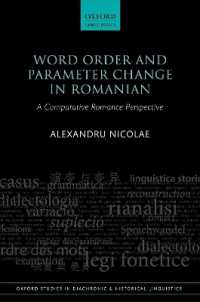Full Description
Formation of transmembrane pores is a very effective way of killing cells. It is thus not surprising that many bacterial and eukaryotic toxic agents are pore-forming proteins. Pore formation in a target membrane is a complex process composed of several steps; proteins need to attach to the lipid membrane, possibly aggregate in the plane of the membrane and finally form a pore by inserting part of the polypeptide chain across the lipid bilayer. Structural information about toxins at each stage is indispensible for the biochemical and molecular biological studies that aim to - derstand how pores are formed at the molecular level. There are currently only two Staphylococcus aureus and hemolysin E from Escherichia coli. Therefore, what we know about these proteins was obtained over many years of intense experimentation. We have nevertheless, in the last couple of years, witnessed a significant rise in structural information on the soluble forms of pore-forming proteins. Surprisingly, many unexpected similarities with other proteins were noted, despite extremely low or insignificant sequence similarity. It appears that lipid membrane binding and formation of transmembrane channels is achieved in many cases by a limited repertoire of structures. This book describes how several of the important pore forming toxin families achieve membrane bi- ing and which structural elements are used for formation of transmembrane pores. Our contributors have thus provided the means for a comparative analysis of several unrelated families.
Contents
Energetics of Peptide and Protein Binding to Lipid Membranes.- Membrane Association and Pore Formation by Alpha-Helical Peptides.- Role of Membrane Lipids for the Activity of Pore Forming Peptides and Proteins.- Cholesterol-Dependent Cytolysins.- Laetiporus sulphureus Lectin and Aerolysin Protein Family.- Interfacial Interactions of Pore-Forming Colicins.- Permeabilization of the Outer Mitochondrial Membrane by Bcl-2 Proteins.- Molecular Mechanism of Sphingomyelin-Specific Membrane Binding and Pore Formation by Actinoporins.- Hemolysin E (HlyE, ClyA, SheA) and Related Toxins.- Pore formation by Cry toxins.- Role of Heparan Sulfates and Glycosphingolipids in the Pore Formation of Basic Polypeptides of Cobra Cardiotoxin.- Amyloid Peptide Pores and the Beta Sheet Conformation.








